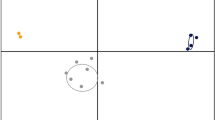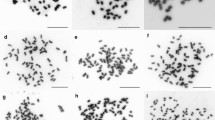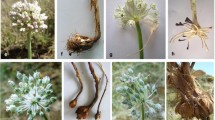Abstract
Populations of polyploid apomictic dandelions consist of a mixture of clonal genotypes that are nearly phenotypically and genetically uniform. Some apomictic taxa are widespread, but many other taxa occur locally or at a single locality. Additionally, certain Central European dandelion populations consist of both diploid sexuals and polyploid apomicts, and the gene flow expected in mixed populations obscures clear genetic and morphological borders among apomictic taxa. In the present study, we investigated genotypic diversity among seven apomictic microspecies coexisting in Central Europe. Using microsatellites, amplified fragment length polymorphism and chloroplast DNA markers, we focused on the clonal structure of apomictic taxa, i.e., whether the studied apomictic taxa are represented by one or a few related genotypes or whether they are represented by many different and unrelated genotypes. The pattern of genotypic diversity within the studied microspecies suggests both intra- and inter-specific genetic diversification. At the intra-specific level, the studied apomictic taxa consist of several related genotypes, and difference among these genotypes is the result of somatic mutations and/or the consequence of repeated origin from different lineages or recent hybridisation. The inter-specific genetic diversity is greater and may reflect a different evolutionary origin of apomictic taxa. Our results show that despite their increased genetic diversity, apomictic dandelions form definable clusters that may be characterised by both molecular markers and morphology.


Similar content being viewed by others
References
Asker SE, Jerling L (1992) Apomixis in Plants. CRC Press, Boca Raton
Battjes J, Menken SBJ, den Nijs HCM (1992) Clonal diversity in some microspecies of Taraxacum sect. Palustria (Lindb. fil.) Dahlst. from Czechoslovakia. Bot Jahrb Syst 114:315–328
Birky CW (1996) Heterozygosity, heteromorphy, and phylogenetic trees in asexual eukaryotes. Genetics 144:427–437
Carman JG (1997) Asynchronous expression of duplicate genes in angiosperms may cause apomixis, bispory, tetraspory, and polyembryony. Bot J Linn Soc 61:51–94
Charleworth D, Morgan MT, Charlesworth B (1993) Mutation accumulation in finite populations. J Hered 84:321–325
Corral JM, Piwczynski M, Sharbel TF (2009) Allelis sequence divergence in the apomictic Boechera holboellii complex. In: Schön I, Martens K, van Dijk PJ (eds) Lost sex: the evolutionary biology of parthenogenesis. Springer, London, pp 495–516
Nijs JCM den (1997) Taraxacum: ploidy levels, hybridization and speciation. The advantage and consequence of combining reproductive systems. Lagascalia 19:45–V
Nijs JCM den, Menken SBJ (1996) Relations between breeding system, ploidy level and taxonomy in some advanced section of Taraxacum. In: Hind DJN, Beentje HJ (eds) Proceedings of the International Compositae Conference, Kew, pp 665–677
den Nijs JCM, Kirschner J, Štěpánek J, van der Hulst A (1990) Distribution of diploid sexual plants of Taraxacum sect. Ruderalia in east-central Europe, with special reference to Czechoslovakia. Pl Syst Evol 170:71–84
Dobeš C, Paule J (2010) A comprehensive chloroplast DNA-based phylogeny of the genus Potentilla (Rosaceae): implications for its geographic origin, phylogeography and generic circumscription. Molec Phylogen Evol 56:156–175
Doll R (1973) Revision der sect. Erythrosperma Dahlst. emend. Lindb. f. der Gattung Taraxacum Zinn. 2.. Teil Feddes Repert 84:1–180
Doyle JJ, Doyle JL (1987) A rapid DNA isolation procedure for small quantities of fresh leaf tissue. Phytochem Bull 19:11–15
Ehrich D (2006) AFLPdat: a collection of R functions for convenient handling of AFLP data. Molec Ecol Notes 6:603–604
Excoffier L, Lischer H (2010) Arlequin suite ver 3.5: a new series of programs to perform population genetics analyses under Linux and Windows. Molec Ecol Res 10:564–567
Falque M, Keurentjes J, Bakx-Schotman T, van Dijk PJ (1998) Development and characterization of microsatellite markers in the sexual-apomictic complex Taraxacum officinale (dandelion). Theor Appl Genet 97:283–292
Fehrer J, Krak K, Chrtek J (2009) Intra-individual polymorphism in diploid and apomictic polyploid hawkweeds (Hieracium, Lactuceae, Asteraceae): disentangling phylogenetic signal, reticulation, and noise. BMC Evol Biol 9:239. doi:10.1186/1471-2148-9-239
Ford H, Richards AJ (1985) Isozyme variation within and between Taraxacum agamospecies in a single locality. Heredity 55:289–291
Hardy OJ, Vekemans X (2002) SPAGeDi: a versatile computer program to analyse spatial genetic structure at the individual or population levels. Molec Ecol Notes 2:618–620
Hughes J, Richards AJ (1988) The genestructure of populations of sexual and asexual Taraxacum (dandelions). Heredity 60:161–171
Huson DH, Bryant D (2006) Application of phylogenetic networks in evolutionary studies. Mol Biol Evol 23:254–267
Kiefer C, Dobeš C, Sharbel FT, Koch MA (2009) Phylogeographic structure of the chloroplast DNA gene pool in North American Boechera—a genus and continental-wide perspective. Molec Phylogen Evol 52:303–311
Kirschner J, Štěpánek J (1994) Clonality as a part of the evolution process in Taraxacum. Folia Geobot Phytotax 29:265–275
Kirschner J, Štěpánek J (1996) Modes of speciation and evolution of the sections in Taraxacum. Folia Geobot Phytotax 31:415–426
Kirschner J, Štěpánek J (1998) A revision of Taraxacum sect. Piesis (Compositae). Folia Geobot 33:391–414
Kirschner J, Štěpánek J, Mes THM (2003) Principal features of the cpDNA evolution in Taraxacum (Asteraceae, Lactuceae): a conflict with taxonomy. Pl Syst Evol 239:231–255
Kitner M, Lebeda A, Doležalová I et al (2008) AFLP analysis of Lactuca saligna germplasm collections from four European and three Middle East countries. Isr J Pl Sci 56:185–193
Kitner M, Majeský Ľ, Gillová L, Vymyslický T, Nagler M (2012) Genetic structure of Artemisia pancicii populations inferred from AFLP and cpDNA data. Preslia 84:97–120
Lo EYY, Stefanović S, Dickinson TA (2010) Reconstructing reticulation history in a phylogenetic framework and the potential of allopatric speciation driven by polyploidy in an agamic complex in Crataegus (Rosaceae). Evolution 64:3593–3608
Loxdale H, Lushai G (2003) Rapid changes in clonal lines: the death of a ‘sacred cow’. Biol J Linn Soc 79:3–16
Majeský Ľ, Vašut RJ, Kitner M, Trávníček B (2012) The pattern of genetic variability in apomictic clones of Taraxacum officinale indicates the alternation of asexual and sexual histories of apomicts. PLoS One 8:e41868. doi:10.1371/journal.pone.0041868
Marciniuk J, Vašut RJ, Marciniuk P, Czarna A (2009) Taraxacum scanicum Dahlst. Group (section Erythrosperma) in Poland: chorology and seed and pollen morphology of the microspecies. Acta Soc Bot Pol 78:115–121
Mártonfiová L, Mártonfi P, Šuvada R (2010) Breeding behavior and its possible consequences for gene flow in Taraxacum sect. Erythrosperma (H. Lindb.) Dahlst. Plant Spec Biol 25:93–102
Matzk F, Meister A, Schubert I (2000) An efficient screen for reproductive pathways using mature seeds of monocots and dicots. Pl J 21:97–108
Meirmans PG, van Tienderen PH (2004) Genotype and Genodive: two programs for the analysis of genetic diversity of asexual organisms. Molec Ecol Notes 4:792–794
Menken SBJ, Morita T (1989) Uniclonal population structure in the pentaploid obligate agamosperm Taraxacum albidum Dahlst. Pl Spec Biol 4:29–36
Menken SBJ, Hans ES, den Nijs JCM (1995) Genetical population structure in plants: gene flow between diploid sexual and triploid asexual dandelions (Taraxacum sect. Ruderalia). Evolution 49:1108–1118
Mes THM, Kuperus P, Kirschner J, Štěpánek J, Štorchová H, Oosterveld P, den Nijs JCM (2002) Detection of genetically divergent clone mates in apomictic dandelions. Molec Ecol 11:253–265
Mogie M (1985) Morphological, developmental and electrophoretic variation within and between obligately apomictic Taraxacum species. Biol J Linn Soc 24:207–216
Mogie M, Ford H (1988) Sexual and asexual Taraxacum species. Biol J Linn Soc 35:155–168
Morita T, Menken SBJ, Sterk AA (1990) Hybridization between European and Asian dandelions (Taraxacum section Ruderalia and section Mongolica). New Phytol 114:519–529
Øllgaard H (1986) Taraxacum discretum sp. nov. (Compositae). Nord J Bot 6:21–24
Paule J, Sharbel TF, Dobeš CH (2011) Apomictic and sexual lineages of the Potentilla argentea L. Group (Rosaceae): cytotype and molecular genetic differentiation. Taxon 60:721–732
Paule J, Scherbantin A, Dobeš C (2012) Implication of hybridization and cytotypic differentiation in speciation assessed by AFLP and plastid haplotypes—a case study of Potentilla alpicola La Soie. BMC Evol Biol 12:132
Paun O, Greilhuber J, Temsch EM, Hörandl E (2006) Patterns, sources and ecological implications of clonal diversity in apomictic Ranunculus carpaticola (Ranunculus auricomus complex, Ranunculaceae). Molec Ecol 15:897–910
R Development Core Team (2009) R: A language and environment for statistical computing. Austria, Vienna
Reisch C (2004) Molecular differentitation between coexisting species of Taraxacum sect. Erythrosperma (Asteraceae) from populations in south-east and west Germany. Bot J Linn Soc 145:109–117
Richards AJ (1970) Eutriploid facultative agamospermy in Taraxacum. New Phytol 69:761–774
Richards AJ (1973) The origin of Taraxacum agamospecies. Bot J Linn Soc 66:189–211
Richards AJ (1989) A comparison of within-plant karyological heterogeneity between agamospermous and sexual Taraxacum (Compositae) as assessed by the nucleolar organizer chromosome. Pl Syst Evol 163:177–185
Schlüter PM, Harris SA (2006) Analysis of multilocus fingerprinting data sets containing missing data. Molec Ecol Notes 6:569–572
Schmid M (2002) Taraxacum multiglossum, eine neue Löwenzahn-Art (Taraxacum G.H. Weber ex Wiggers) aus der Sektion Erythrosperma (H Lindb. fil.) Dahlst. von der Fränkischen Alb. Ber Bayer Bot Ges 72:103–109
Schmid M, Vašut RJ, Oosterveld P (2004) Taraxacum prunicolor sp. nova, a new species of the Taraxacum scanicum group (sect. Erythrosperma). Feddes Repert 115:220–229
Simon JC, Delmotte F, Rispe C, Crease T (2003) Phylogenetic relationships between parthenogens and their sexual relatives: the possible routes to parthenogenesis in animals. Biol J Linn Soc 79:151–163
Šuvada R, Mártonfi P, Mártonfiová L (2012) Differentiation of diploid and triploid taxa within Taraxacum sect. Erythrosperma (Asteraceae) from the Pannonian region. Folia Geobot 47:69–91
van der Hulst RGM, Mes THM, Falque M, Stam P, den Nijs JCM, Bachmann K (2003) Genetic structure of a population sample of apomictic dandelions. Heredity 90:326–335
van Dijk PJ, Bakx-Schotman JMT (2004) Formation of unreduced megaspores (diplospory) in apomictic dandelions (Taraxacum) is controlled by a sex-specific dominant gene. Genetics 166:483–492
van Oostrum H, Sterk AA, Wijsman HJW (1985) Genetic variation in agamosperous microspecies of Taraxacum sect. Erythrosperma and sect. Obliqua. Heredity 55:223–228
Vašut RJ (2003) Taraxacum sect. Erythrosperma in Moravia (Czech Republic): taxonomic notes and the distribution of previously described species. Preslia 75:311–338
Vašut RJ, van Dijk PJ, Falque M, Trávníček B, de Jong JH (2004) Development and characterization of nine new microsatellite markers in Taraxacum (Asteraceae). Molec Ecol 4:645–648
Vašut RJ, Štěpánek J, Kirschner J (2005) Two new apomictic Taraxacum microspecies of the section Erythrosperma from Central Europe. Preslia 77:197–210
Verduijn MH, van Dijk PJ, van Damme JMM (2004) The role of tetraploids in the sexual-asexual cycle in dandelions (Taraxacum). Heredity 93:390–398
Whitton J, Sears CJ, Baack EJ, Otto SP (2008) The dynamic nature of apomixis in the angiosperms. Int J Pl Sci 169:169–182
Wilkinson M (2001) PICA 4.0: Software and documentation. Department of Zoology, The Natural History Museum, London
Wittzell H (1999) Chloroplast DNA variation and reticulate evolution in sexual and apomictic sections of dandelions. Molec Ecol 8:2023–2035
Záveská-Drábková L, Kirschner J, Štěpánek J, Záveský L, Vlček Č (2009) Analysis of nrDNA polymorphism in closely related diploid sexual, tetraploid sexual and polyploid agamospermous species. Pl Syst Evol 278:67–85
Acknowledgments
We thank Petra Macháčková for performing the FCSS analyses. LM thanks Mária Čudejková for patience and support. The research was supported by a grant from the Czech Science Foundation [206/09/P356 to RJV, 206/09/1126 to RJV], Internal Grant Agency of the Palacký University funds [PrF-2013-003, IGA_PrF_2014001, PrF_2015_001], European Social Fund, The Education for Competitiveness Operational Programme [CZ.1.07/2.3.00/30.0004 to LM], and Ministry of Education, Youth and Sports of the Czech Republic [MSM 6198959215 to MK].
Conflict of interest
The authors have declared that there is no conflict of interest.
Author information
Authors and Affiliations
Corresponding author
Additional information
Handling editor: Karol Marhold.
Electronic supplementary material
Below is the link to the electronic supplementary material.
Appendix
Appendix
See Table 4.
Rights and permissions
About this article
Cite this article
Majeský, Ľ., Vašut, R.J. & Kitner, M. Genotypic diversity of apomictic microspecies of the Taraxacum scanicum group (Taraxacum sect. Erythrosperma). Plant Syst Evol 301, 2105–2124 (2015). https://doi.org/10.1007/s00606-015-1218-x
Received:
Accepted:
Published:
Issue Date:
DOI: https://doi.org/10.1007/s00606-015-1218-x




